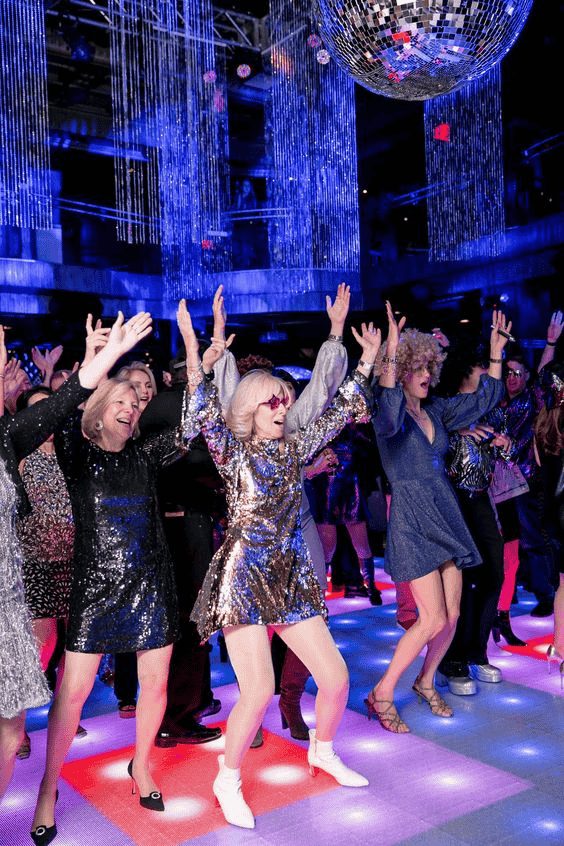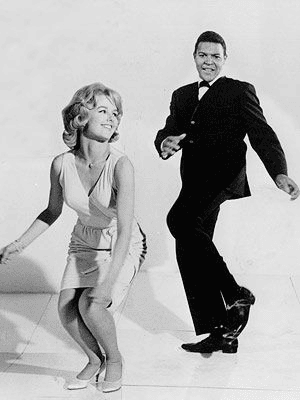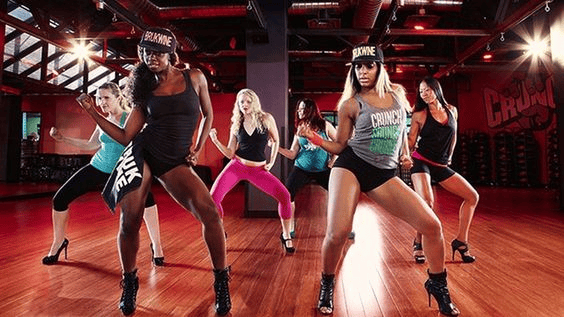Want to take a trip down memory lane? The 1970s is perfect for that since it was a groovy decade bursting with aesthetic outfits, funky music, and unforgettable dance moves.
That’s no wonder. The impact of 70s dance culture brought us legendary dance floors, iconic moves like the Hustle, and the electrifying energy of disco fever.
Whether you’re a disco diva or a soul sensation, let me help you channel the spirit of the 70s and boogie the night away.
But how will you rock the dance floor of a 70s themed party? That’s easy! The trick is to express yourself through bold and funky styles. That way, you can groove into the dazzling world of the 70s.
Read on to learn more about the best dancing shoes that will prepare you to strut, making your 70s themed party a night to remember!

Credits: @partyslate /Pinterest
Key Takeaway
- The 1970s was a vibrant era for dance, characterized by iconic moves, popular line dances, and influential music styles like disco.
- Many classic dance moves from this period, such as the Bus Stop, YMCA, and various line dances, remain popular and easy to learn for beginners.
- The decade saw a fusion of different dance influences, blending elements from earlier eras with new rhythms and styles.
- Mastering 70s dance moves involves learning basic steps, practicing regularly, and embracing the era’s spirit of self-expression and fun.
Popular 70s Dance Moves
Before getting on the dance floor, remember that the 1970s were a time of fantastic music, flashy outfits, and unforgettable dance moves. Explore some popular dance moves from this groovy era, and get ready to hit the dance floor!
The Bus Stop
The Bus Stop tops our list as this line dance was a hit at every party and disco. Inspired by the song “The Hustle” by singer Van McCoy, The Bus Stop had everyone moving in sync.
What’s more, it was a simple line dance that anyone could learn, making it perfect for large gatherings. People loved it because it brought everyone together, moving in the same direction and feeling the beat of the music.
Step-by-Step Guide
But how do you do this? Here’s a quick guide to get you started:
- Start with your left foot, and take a step to the left.
- Bring your right foot to meet your left foot.
- Take another step to the left with your left foot.
- Tap your right foot next to your left foot.
- Repeat the steps, but this time, start with your right foot to the right.
- Add a little spin or a funky move if you’re feeling adventurous!
Saturday Night Fever
We can’t talk about 70s dance moves without mentioning Saturday Night Fever. This movie greatly influenced dance culture and introduced us to some of the most iconic routines ever.
Saturday Night Fever, starring John Travolta, showcased the best disco dancing. The movie made everyone want to hit the dance floor and try out the moves they saw on screen.
Line dances, such as The Bus Stop and the Chicken Dance (also known as the Funky Chicken), became even more popular.
Iconic Scenes and Dance Routines
Who can forget John Travolta’s epic dance scenes in Saturday Night Fever? His smooth moves and stylish outfit became the gold standard for disco dancing. From the opening scene, where he struts down the street, to the energetic dance-offs at the disco.
Every moment was packed with unforgettable choreography.
So, whether you’re practicing The Bus Stop, decorating your dance space, or reliving the magic of Saturday Night Fever, get ready to dance the night away just like they did in the 70s!
The Village People and YMCA

Credits: @olafsings /Pinterest
When it comes to 70s dance moves, we can’t forget about The Village People and their smash hit “YMCA.” This song isn’t just catchy; it comes with its own set of signature moves that everyone loves.
I remember the first time I saw a crowd of disco dancers spelling out “Y-M-C-A” with their arms – it was pure magic! These moves have left a lasting cultural impact, making “YMCA” a must-play at any party.
Well, that’s because The Village People brought us a song and an entirely easy and fun dance style.
The signature “YMCA” moves are a hit at weddings, parties, and sports events. The best about this? You can’t help but join in and spell out the letters with everyone else. It’s incredible how these basic moves can bring so much joy and connect people across generations.
Learning the Steps
Don’t worry if you’ve never tried it before! Learning the steps to “YMCA” is super simple. The best part is that it’s a solo dance, so you don’t need a partner.
Just follow along with the basic steps: making a “Y” by raising your arms, forming an “M” by bending your elbows, creating a “C” with your right arm, and finally, an “A” by touching your fingertips above your head.
It’s a fun mixture of swing and rhythm that anyone can master.
Iconic 70s Dancers
Iconic 70s dancers like John Travolta became symbols of the era, bringing unique styles and unforgettable moves to the dance floor. Travolta’s performances in “Saturday Night Fever” showcased his smooth, confident style, blending sharp, precise steps with flowing motions.
His signature move, the “basic step,” involved gliding across the dance floor with perfect rhythm, adding flair to each step. Travolta’s impact on pop culture was immense, inspiring a generation to learn disco moves and bringing disco dancing into the mainstream.
But Travolta wasn’t the only one lighting up the dance floors. The era was filled with legendary disco dancers who popularized moves like the “Chicken Wings” and the “Latin Hustle.”
These dancers, especially those featured on “Soul Train,” combined basic disco rhythms with inventive steps, creating a dance revolution that spread from the East Coast to New York.
The influence of these 70s dancers is still visible today, with modern dance routines often incorporating the basic disco steps.
Dance classes worldwide continue to teach these classic moves, ensuring the spirit of 70s disco dancing lives on. Whether practicing your third step or grooving to a 70s beat, you’re part of a long tradition that keeps the vibrant energy of disco alive.
Learning the Moves
Here’s a guide through the basics, from simple steps to popular line dances. This will help you confidently hit the dance floor.
First, feel the disco rhythm—like a steady heartbeat: boom, boom, boom. Tap your feet to the beat to get comfortable, then move on to essential moves like the “Side Step” and “Step-Touch.”
Coordination is key.
Start with the “Left Foot Tap”: stand with feet hip-width apart, tap your left foot forward and back, and repeat until smooth.
Next, try the “Left Foot Side Step”: step your left foot out to the side and back to the middle to shift your weight and balance.
Switch to your right foot and repeat these exercises. Regular practice will make these movements feel natural and boost your confidence on the dance floor.
Line Dances
Besides the dance moves above, several iconic line dances rose to prominence here, becoming synonymous with disco culture.
The Hully Gully
Although its origins date back to the 1960s, the Hully Gully remained a disco favorite in the 1970s. Its simplicity, featuring a quarter turn at the end of each sequence, kept dancers engaged and energized.
Here’s a step-by-step guide to rock The Hully Gully:
- Start Position: Begin with your feet together and your arms relaxed at your sides.
- Step to the Side: Step your right foot to the side.
- Step Together: Bring your left foot to meet your right foot.
- Step to the Side: Step your left foot to the side.
- Step Together: Bring your right foot to meet your left foot.
- Quarter Turn: Step to the right with your right foot, then turn a quarter turn to the left.
- Repeat: Continue the sequence, always stepping to the side together and turning at the end of each sequence.
The Nutbush City Limits
This high-energy line dance gained a solid following among disco enthusiasts for its infectious beat and easy-to-follow steps. Here are the steps:
- Start Position: Stand with your feet together and your arms at your sides.
- Step Forward: Step your right foot forward, then bring your left foot to meet it.
- Step Back: Step your right foot back, then bring your left foot to meet it.
- Heel-Tap: Tap your right heel forward, then your left heel forward.
- Step to the Side: Step your right foot to the side, then your left foot to the side.
- Step Together: Bring your right foot to meet your left foot, then your left foot to meet your right foot.
- Repeat: Now, try stepping forward, then back, throw in some heel taps, and don’t forget those side steps. Feel the rhythm and energy of the beat as you go. Keep the flow going, and have fun with it!
The Electric Slide (Hot Chocolate)
Derived from the 1961 Hully Gully, this simplified dance routine quickly became a staple at social gatherings and continues to be popular today. Learning these line dances often involves practicing with friends or at dance events where participants can follow along with the group.
- Start Position: Stand with your feet together, arms relaxed at your sides.
- Step Right: Step your right foot to the right.
- Step Left: Step your left foot to the left.
- Step Right Together: Bring your right foot to meet your left foot.
- Step Left Together: Bring your left foot to meet your right foot.
- Step Forward: Step your right foot forward.
- Step Forward: Step your left foot forward.
- Step Back: Step your right foot back.
- Step Back: Step your left foot back.
- Turn: Turn a ¼ turn to the right, stepping right, left, right, and left.
- Repeat: After you’ve practiced with both feet individually, let’s mix it up. Alternate steps to the right, forward, and back, all while staying in sync with the music. This helps you get a feel for different movements and keeps things lively.
These line dances were integral to the disco era, defining its unique style and vibrant energy and leaving an enduring mark on dance culture. Whether you’re a beginner or a seasoned dancer, mastering these moves is a fun way to connect with the rhythm and spirit of disco.
Classic 70s Dance Styles
A blast from the past isn’t complete without discussing some of the coolest dance styles from the 1970s. From the groovy vibes of disco to the funky beats of the Hustle, the 1970s were all about having fun on the dance floor.
Disco Dancing
Disco was all about glitz, glamour, and getting down to some seriously catchy tunes. Think of flashy outfits, spinning disco balls, and crowded dance floors. The moves were smooth and rhythmic, perfect for showing off under the lights.
And that’s why disco dancing was a social activity, bringing people together to share in the excitement of the beat.
When you think of disco, you can’t help but remember some of the biggest hits that got everyone moving. Songs like “Stayin’ Alive” by the Bee Gees and “Dancing Queen” by ABBA were anthems of the era.
These tracks had infectious rhythms and melodies that made it impossible to stay seated. And up to now, the groove to these timeless tunes lets us feel the spirit of disco!
Funky Chicken and Chicken Dance

Credits: @collectorswkly /Pinterest
The Funky Chicken is as fun as it sounds! This quirky dance move is about letting loose and having a good time. Imagine flapping your arms like a chicken and adding some funky twists and turns.
It’s easy to learn, and we can dance to it to bring smiles.
The chicken dance is a hit at parties and gatherings with its simple steps and silly motions. The dance involves flapping your arms, wiggling your hips, and moving in a circle with your friends. It’s all about embracing the fun and not taking yourself too seriously.
So, if you want a 70s dance-themed party, do the Chicken Dance and cluck your way to happiness!
The Latin Hustle
The Latin Hustle adds a spicy twist to the traditional hustle.
It’s a smooth, stylish, and full-of-flair partner dance. Originating from the streets of New York, the Latin Hustle mixes Latin rhythms with classic disco moves, creating a dynamic and energetic dance.
The basics of the Latin Hustle are all about rhythm and connection with your dance partner.
It involves simple steps, spins, and syncopated movements that flow with the music. The key is to keep the rhythm steady and let the music guide your steps. Whether you’re a beginner or an experienced dancer, the Latin Hustle is a fantastic way to get your groove on.
More 70s Dance Inspirations
What’s fascinating about the 1970s is that it was a wild time for music and dance, blending old styles with new beats. Here are some iconic dance inspirations from that groovy decade.
Soul Train
Soul Train was more than just a TV show; it was a cultural phenomenon. It aired from 1970 to 2006 and became the go-to place for the hottest dance moves and coolest music.
What’s more, Soul Train, created by Don Cornelius, became a vital platform for African American music and dance. It showcased soul, funk, and R&B artists and played a huge role in bringing black culture into the mainstream.
For many, watching Soul Train was a Saturday morning ritual. It wasn’t just about the music but the style, the fashion, and, most importantly, the dance moves.
When it comes to iconic dance moves, Soul Train delivered. The “Soul Train Line” was legendary – two lines of dancers face each other while pairs of dancers take turns strutting down the middle, showing off their best moves.
We saw the rise of dances like the Robot, the Locking, and the Pop-and-Lock, which have influenced dance styles today.
A mixture of Swing and Early 60s Influence
The 70s weren’t just about disco balls and bell bottoms. The dance styles were a rich mix of earlier influences, especially from the swing era and the early 60s.
Swing dancing originated in the 1920s and 30s and made a surprising comeback in the 70s.
Dancers started mixing swing steps with disco rhythms, creating a unique, energetic, and smooth fusion. Think of it as the lively steps of swing meeting the funky beats of disco – it was a match made in dance heaven.
The early 60s brought us dances like the Twist, the Mashed Potato, and the Watusi.
These dances laid the groundwork for many 70s moves. The 70s dancers took the simple, fun steps of the 60s and added their own flair, making them more complex and visually exciting.
Advanced Dance Techniques
The basics are good, but learning the advanced dance techniques is way better! Whether you’re a seasoned dancer or looking to elevate your skills, you can shine more on the dance floor with these techniques.
Solo Dance Performances
Dancing solo can be thrilling yet nerve-wracking.
The spotlight is all on you, and captivating the audience is your moment. Confidence is key. Remember, every dancer has their own flair, so don’t shy away from expressing yours.
Getting insights from experienced dancers can be a game-changer.
They’ve been in your shoes and know what it takes to stand out. Tips like maintaining good posture, connecting emotionally with the music, and perfecting your timing can make a huge difference. These nuggets of wisdom can help you transform from a good dancer to a great one.
Dance Classes and Practice

Credits: @lgrantpat /Pinterest
Finding the right dance class is essential whether you want to learn a new style or improve your current skills.
Look for classes that match your skill level and interest. Don’t be afraid to try various classes until you find the perfect fit. Local studios, community centers, and even online platforms offer various options.
Consistency is key to becoming a better dancer. Practicing at home allows you to work on techniques and routines at your own pace. Set aside regular practice times, and create a dedicated space to dance freely.
Third Step and Basic Moves
The third step is a fundamental move that can add depth and complexity to your dance routines. Mastering this step requires patience and practice. Breaking it down into smaller chunks and focusing on each element can help you feel comfortable.
You can incorporate it seamlessly into your dances once you’ve got the hang of it.
Combining Basic Moves
Combining basic moves is like building blocks for more advanced choreography.
Start with simple steps and gradually link them together. Experiment with different combinations to see what flows naturally. This will not only improve your skills but also help you discover your own unique style.
By mastering these advanced dance techniques, you’ll be well on your way to captivating performances and a deeper love for dance.
Conclusion
Now that you’ve got the techniques down, it’s time to unleash your inner star.
Think of the energy and style of the 70s—bold, vibrant, and full of life. Channel that spirit every time you step onto the dance floor. Don’t be afraid to be expressive and have fun with your moves.
Put on your dancing shoes, let the music take over, and dance like a 70s star! Feel the joy and freedom that dancing brings. Happy dancing!
